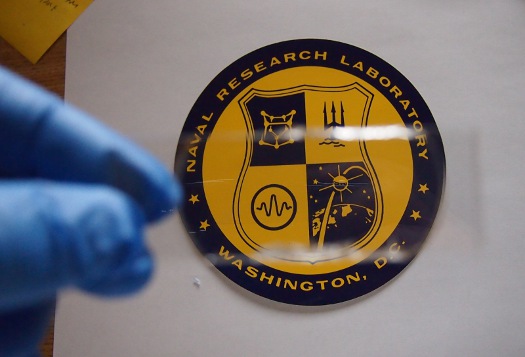 |
| April 25, 2017 | Volume 13 Issue 16 |
Designfax weekly eMagazine
Archives
Partners
Manufacturing Center
Product Spotlight
Modern Applications News
Metalworking Ideas For
Today's Job Shops
Tooling and Production
Strategies for large
metalworking plants
Navy Research Lab develops lighter, field-repairable transparent armor

The NRL-developed transparent polymer armor consists of alternating layers of elastomeric polymer and a harder material substrate. Very small crystalline domains, which also provide rigidity, give the polymer its transparency. [Image: U.S. Naval Research Laboratory]
Research chemists at the U.S. Naval Research Laboratory (NRL) have developed and patented a transparent thermoplastic elastomer armor to reduce weight, inherent in most bullet-resistant glass, while maintaining superior ballistic properties.
Thermoplastic elastomers are soft, rubbery polymers converted by physical means, rather than a chemical process, to a solid. Consequently, the solidification is reversible and enables damaged armor surfaces to be repaired "on the fly" in the field.
"Heating the material above the softening point, around 100 degrees Celsius, melts the small crystallites, enabling the fracture surfaces to meld together and reform via diffusion," said Dr. Mike Roland, senior scientist, NRL Soft Matter Physics. "This can be accomplished with a hot plate, akin to an iron, that molds the newly forming surface into a smooth, flat sheet with negligible effect on integrity."
Up to now, NRL scientists have tested the use of polymeric materials as a coating to achieve improved impact resistance of hard substrates. Applying polyurea and polyisobutylene layers enhances the ballistic performance of armor and helmets, and achieves greater ballistic effectiveness and mitigation of blast waves.
By using a variation of employing thermoplastic elastomers, NRL scientists are able to recreate superior ballistic properties of polyurea and polyisobutylene coatings, with the added benefit of the material being transparent, lighter than conventional bullet-resistant glass, and repairable.
"Because of the dissipative properties of the elastomer, the damage due to a projectile strike is limited to the impact locus. This means that the effect on visibility is almost inconsequential, and multi-hit protection is achieved," Roland said.
Roland told Designfax exclusively that compared to current coating technologies in use, "We can, at equal weight, enhance the ballistic performance on the order of 50 percent."
That number could go up or down, explained Roland, depending on a number of factors. For instance, if you are not concerned as much about transparency, that number could change, because the coating material could be thicker, for example. The type of surface the material is applied to could also make a difference.
The applied material coating is usually about 2 to 3 mm thick, Roland said.
Roland also told Designfax that, in terms of weight, this material can maintain ballistic performance and reduce the weight by 40 percent when compared to other coating materials currently used in the target applications.
In this particular case and application focus, though, keeping the transparency is important. Target applications include military vehicles and transport infrastructure, helmets, and body armor (including face shields). Other business sectors could also eventually benefit from the material's development, including police protection, for example, in the case of face/helmet shields or windshields.
NRL's transparent thermoplastic elastomer armor technology is covered by U.S. Patent #9,285,191; "Polymer Coatings for Enhanced and Field-Repairable Transparent Armor."
Source: U.S. Naval Research Laboratory
Published April 2017
Rate this article
View our terms of use and privacy policy
